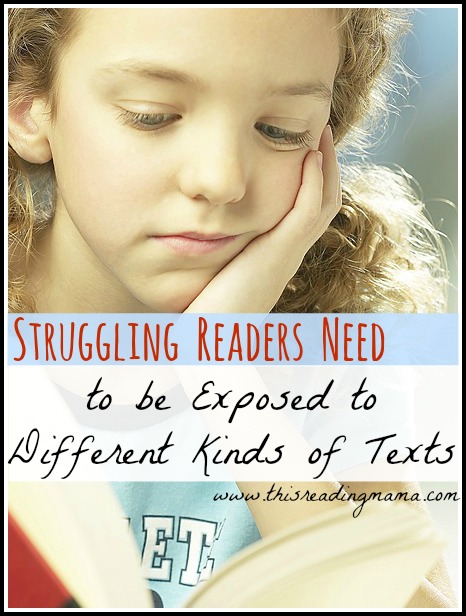We made it! This is the last of my Struggling Reader series. If you’re new to This Reading Mama, you can click HERE or on the image above to see all nine posts from this series.
*This post contains affiliate links. Please read my disclosure policy for more information.
Today I’d like to focus on how struggling readers need to be exposed to different kinds (genres) of texts, especially nonfiction. I’ve noticed this need particularly as students enter the 2nd and 3rd grades. Many (not all) teachers and mamas tend to read a lot of fiction to our younger kids. This is WONDERFUL but as students get older, they need to also be familiar with nonfiction.
Why Do Kids Need to Read Non-fiction?
- Non-fiction is very different than fiction in many ways, including how the information is presented. If kids aren’t familiar with the features and structures of non-fiction, it can make it very difficult to comprehend it.
- As students begin to take those standardized reading tests (in school and homeschool settings), much of the text students have to read for these tests is nonfiction.
- Lucy Calkins reminds us in The Art of Teaching Reading that “non-fiction will [also] be the primary reading fare of each of our students” as they become adults. (pg. 437)
- Non-fiction gives kids the chance to read about something they enjoy. Non-fiction texts can be found on almost any topic you can think of. Do you have a son who enjoys soccer? Get him some texts about it! Does your daughter collect dolls? Find texts on that subject. Non-fiction has the potential of getting kids more excited about reading that fiction if you hone in on their passions and hobbies.
Allington spends some time talking about how we as teachers need to “provide multiple opportunities for students to select reading material from a wide range of texts.” (pg. 170) By wide range, I’m sure he means more than just nonfiction, like: magazines, poetry, science fiction, the newspaper, realistic fiction, historical fiction, fairy tales, etc. I love his suggestion for the adult to “bless” books by holding them up and giving just a teaser about it so that if kids are interested, they can read the book. (pg. 171)
 {photo credit}
{photo credit}
Where can we find a variety of texts? Of course, you can always buy texts, but I thought I’d suggest three completely free places: the library (our local library allows you to check out up to 99 books at a time!!), the internet, and swapping or borrowing them from another friend or teacher.
Allington focuses in on using the internet to teach nonfiction in particular. He says that sometimes adults worry that the internet will hinder reading, but he says that “few websites offer information in a manner that makes reading proficiency irrelevant.” (172) The best part is that these sites are interactive and FREE!
Some of my Favorite Sites for Non-fiction are:
- Time For Kids– they’ve since redone their website, but they used to have old articles from their magazines listed by grade level (grades 2-6). They still have archived articles, but they don’t list the grade level of each one.
- Science News for Kids– this site is more for upper elementary and middle school kids, but is a great, free place for nonfiction articles.
- National Geographic for Kids– very similar to Science News for Kids
Do you have any favorite non-fiction texts you’d like to share?
More Non-fiction Text Resources:
- Non-fiction Text Features and Structures
- Non-fiction Text Structure Resources {FREE Printable Pack included!}
- More Non-fiction Text Structure Resources {FREE Printable Pack included!}
~Becky

Thank you so much for creating this site!!!